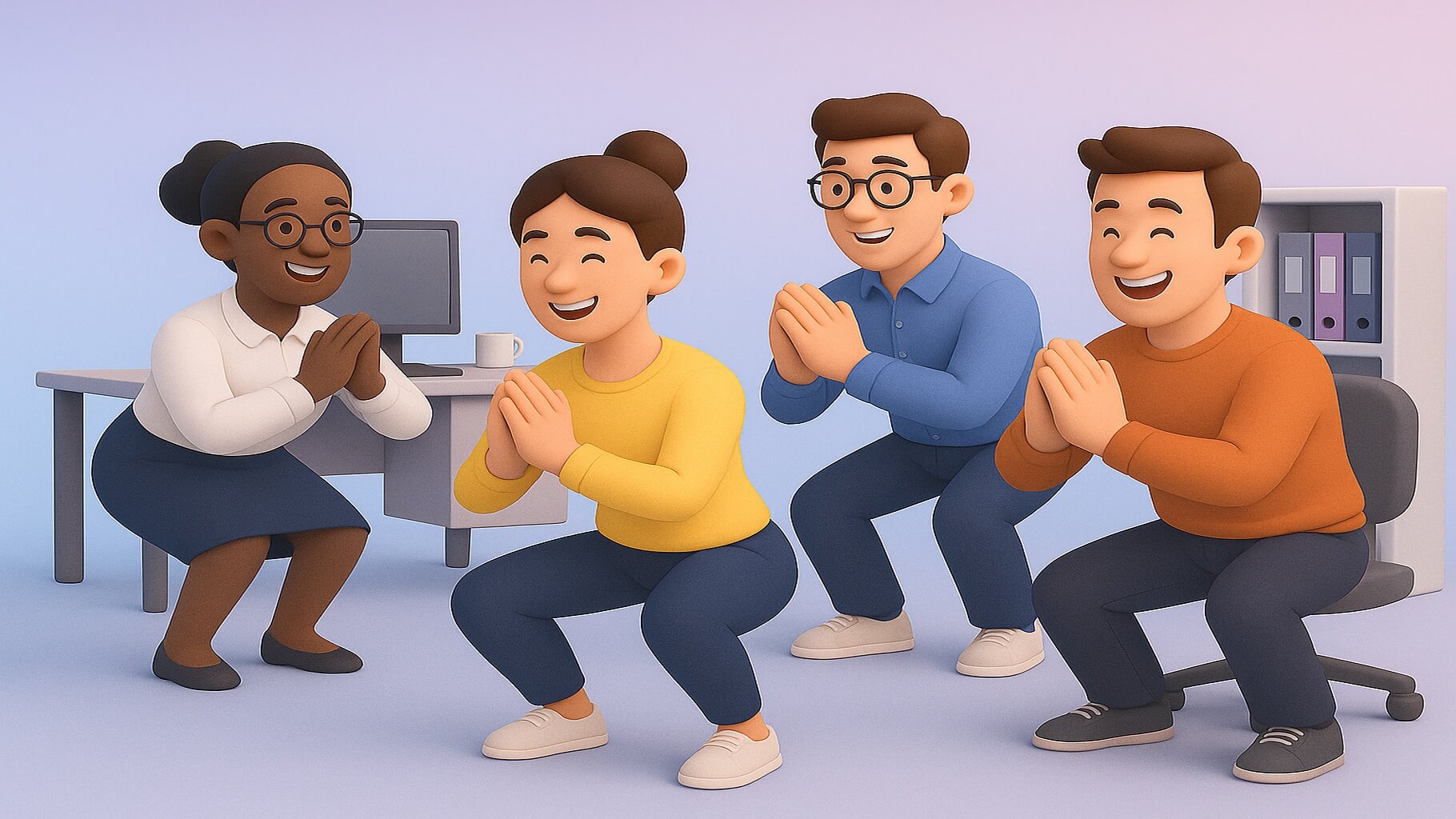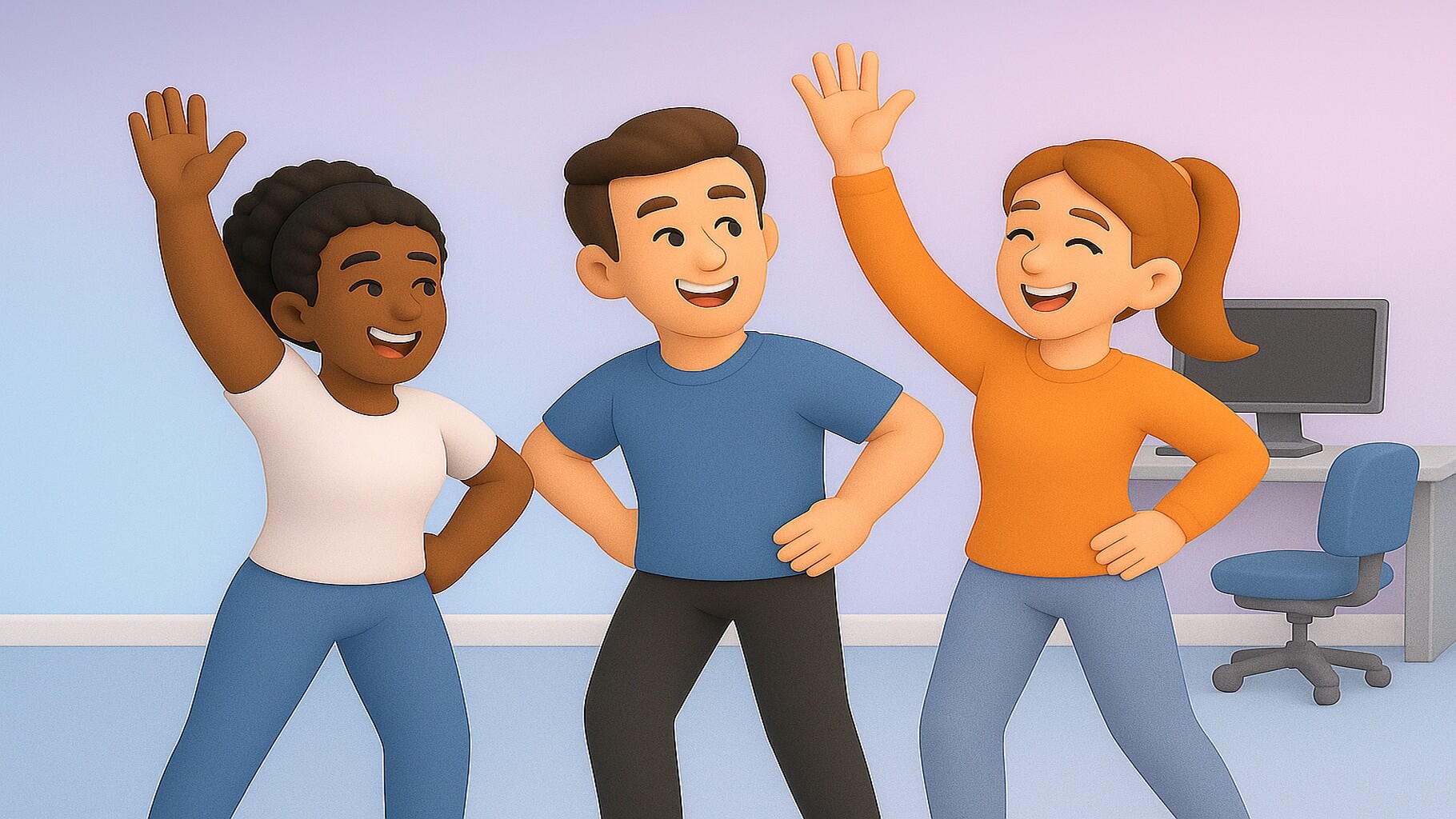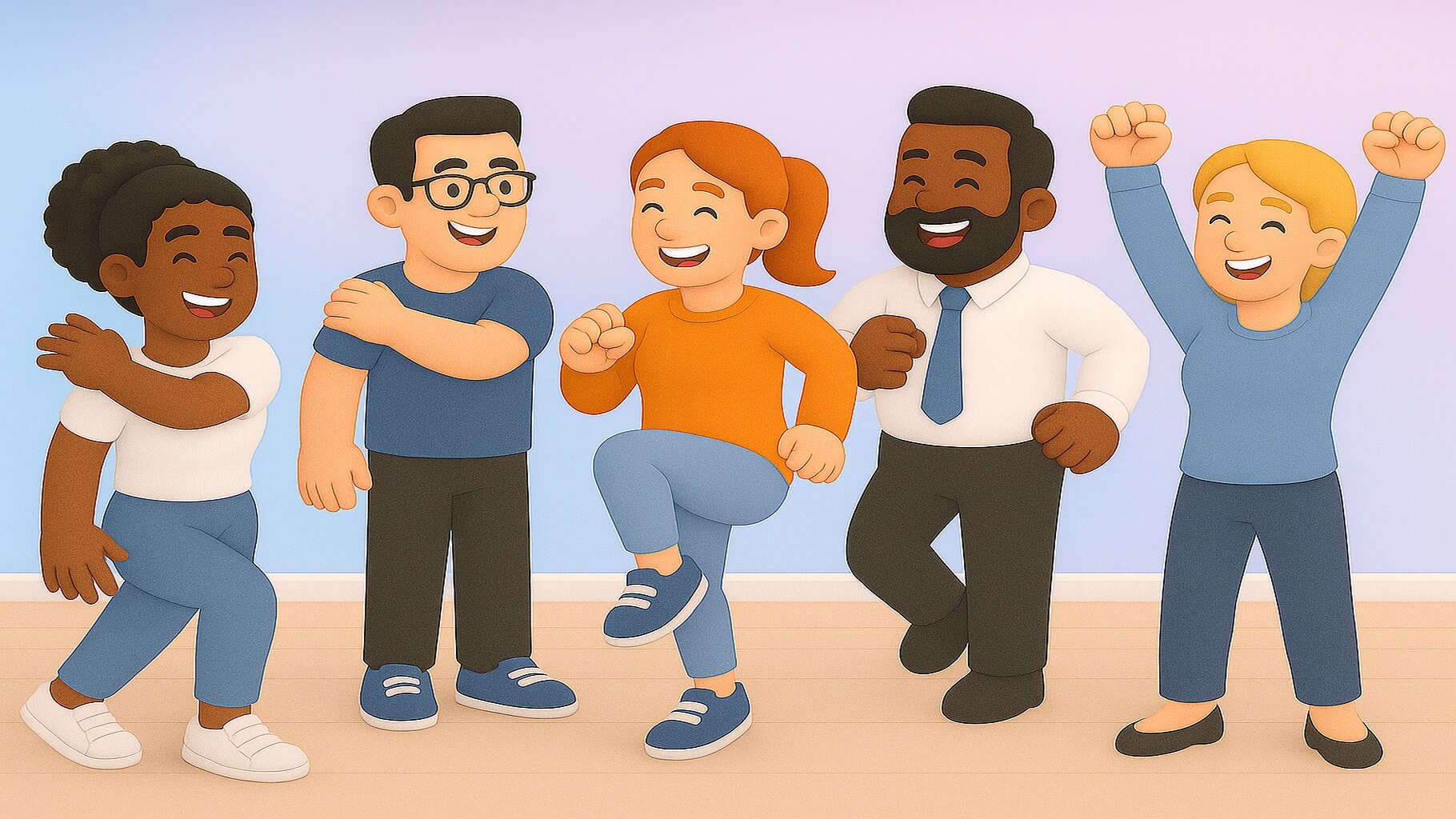
Developing a workplace that values employee health and wellness has become essential for modern organizations seeking sustainable success. At Matter, we recognize that implementing effective office exercise challenges can transform workplace culture while addressing the diverse needs of today's workforce. Many companies struggle to engage employees in wellness initiatives, facing barriers like limited space, varied fitness levels, competing priorities, and the challenge of maintaining long-term participation in wellness programs.
The good news is that well-designed fitness challenges can overcome these obstacles while creating lasting positive change across physical health, mental health, and organizational performance. By incorporating creative movement opportunities throughout the workday and combining them with proper nutrition and stress management strategies, organizations can develop comprehensive wellness programs that employees genuinely adopt and embrace. This guide offers over 57 proven challenge ideas, implementation strategies, and practical solutions to help you launch successful wellness initiatives that deliver real results.
Why do office exercise challenges create healthier workplaces?

Office exercise challenges serve as powerful catalysts for transforming workplace wellness by addressing multiple aspects of employee health and well-being simultaneously. These structured programs create accountability through team-building challenges while fostering community and making fitness accessible to all team members regardless of their current fitness levels or physical limitations. When organizations implement thoughtful wellness challenges that consider both physical and mental health components, they see improvements in employee engagement, reduced healthcare costs, enhanced productivity, and stronger team cohesion.
The impact extends far beyond physical fitness alone, encompassing enhanced mental well-being and a higher overall quality of life. Regular movement throughout the workday helps combat the negative effects of prolonged sitting, reduces stress levels, enhances cognitive function, and promotes better health behaviors across the organization. By creating opportunities for employees to prioritize their well-being during work hours, companies demonstrate genuine care for their teams' holistic health, which translates into increased loyalty, job satisfaction, and sustainable performance improvements.
The science behind successful work exercise challenge programs
Research consistently shows that comprehensive workplace wellness challenges deliver measurable benefits for both employees and organizations when properly designed and implemented. Studies indicate that employees who participate in well-structured wellness programs experience significant improvements across multiple health metrics and performance indicators.
The physiological and psychological benefits include:
- Improved cardiovascular health through regular movement, increased daily step counts, and structured exercise programs.
- Enhanced mental health and emotional resilience from endorphin release, stress reduction techniques, and social connection
- Better sleep quality and recovery leading to improved focus, decision-making abilities, and sustained energy levels
- Stronger immune systems and disease prevention lead to fewer sick days and lower healthcare costs.
- Enhanced energy and vitality throughout the workday, thereby reducing afternoon slumps and ensuring productivity.
The key to successful programs lies in their holistic design and thoughtful implementation strategies. Challenges that incorporate social elements, have clear and achievable goals, appropriate difficulty progressions, and recognition for participation, see the highest engagement rates. When employees feel supported rather than pressured, they're more likely to adopt lasting health behaviors that persist long after formal challenges end.
How fitness challenges for workplace improve productivity
The connection between physical activity and workplace performance is well-documented through extensive research across industries. Employees who engage in regular exercise through structured employee wellness challenges demonstrate improved concentration, better problem-solving abilities, enhanced creativity, and stronger resilience to workplace stress. These fitness challenges create structured opportunities for movement that directly impact work outcomes while building a positive workplace culture.
Organizations implementing comprehensive workplace wellness challenges report significant productivity gains, including:
- Reduced afternoon energy slumps through strategically timed midday movement breaks and proper nutrition
- Improved team collaboration and communication from shared wellness goals and group activities
- Enhanced mood and emotional regulation leading to better customer interactions and workplace relationships
- Decreased absenteeism and presenteeism due to improved overall health and stress management
- Stronger focus and sustained attention from regular brain-boosting exercise and mindfulness practices
These benefits compound exponentially over time as employees develop sustainable fitness habits and health behaviors. The social component of team challenges also fortifies workplace relationships, cultivating an environment that is more cohesive and supportive, allowing employees to thrive in both their personal and professional lives.
Real benefits of implementing office exercise challenge initiatives
Beyond the immediate health improvements and productivity gains, office challenges deliver tangible business benefits that justify the investment and create lasting organizational value. Companies tracking wellness program outcomes report reduced healthcare costs, improved employee retention, enhanced recruitment appeal, and stronger employer brand recognition when they prioritize comprehensive workplace wellness.
The most impactful and measurable benefits include:
- Increased employee morale and job satisfaction through shared achievements, peer recognition, and visible organizational support
- Stronger company culture and values alignment built on mutual support, encouragement, and collective well-being
- Enhanced employer brand and talent attraction, appealing to health-conscious professionals seeking supportive work environments.
- Reduced stress-related issues and burnout leading to better workplace dynamics and sustainable performance
- Improved work-life integration by incorporating wellness seamlessly into the workday routine
Organizations that systematically track these metrics often find that comprehensive wellness initiatives deliver strong ROI through reduced turnover, lower insurance premiums, decreased workers' compensation claims, and increased productivity. The key is choosing challenges that align with company values while meeting employees where they are in their wellness journeys.
15 fun office fitness challenges for daily energy

Creating daily movement opportunities doesn't require expensive equipment, extensive time commitments, or dedicated fitness facilities. The most successful fun office challenges integrate seamlessly into existing workplace routines while providing enough variety to maintain long-term interest and engagement. These 15 challenges are specifically designed to boost energy levels throughout the workday while accommodating different fitness interests, physical abilities, and workplace constraints.
15 daily office exercise challenges to energize your team:
- Step count competitions with daily and weekly leaderboards tracking progress
- Desk yoga sessions during scheduled break times, incorporating breathing exercises
- Walking meetings for brainstorming sessions, one-on-ones, and team discussions
- Stair climbing challenge tracking floors climbed daily with milestone rewards
- Dance break challenges with themed music playlists celebrating diverse cultures
- Stretching circuits targeting common desk-work tension areas and posture improvement
- Plank challenge progressions starting at 30 seconds with weekly increases
- Water bottle workouts using everyday items as resistance training tools
- Balance challenges improve stability, core strength, and fall prevention
- Breathing exercises for stress reduction, focus enhancement, and emotional regulation
- Wall push-up progressions build upper body strength without equipment
- Lunch hour walking clubs explore nearby areas while building social connections
- Posture check reminders with corrective exercises and ergonomic education
- Energy boost circuits combining cardio and strength moves for afternoon vitality
- Mindful movement sessions blending meditation with gentle exercise for mental health
Morning fun office fitness challenges that energize
Starting the day with purposeful movement sets a positive tone that enhances both physical energy and mental well-being throughout the workday. Morning challenges work best when they're brief, energizing, accessible to all fitness levels, and designed to prepare both body and mind for peak performance. The goal is to wake up the body's systems and activate cognitive function without causing fatigue that could impact work performance.
Effective morning challenges that boost employee health focus on:
- Dynamic stretching routines that prepare muscles for daily activities while preventing injury
- Brief cardio bursts to increase heart rate, alertness, and morning energy levels
- Team huddle exercises combining movement with daily planning and goal setting
- Energizing breathing techniques to boost oxygen flow and mental clarity
- Quick balance challenges that improve focus, coordination, and mind-body connection
These activities should feel invigorating rather than exhausting, establishing a constructive basis for the remaining hours of the day. Encourage workers to participate at the level that is most comfortable for them, emphasizing that any movement is beneficial for overall health. Consider rotating challenge leaders from different departments to maintain variety and give team members ownership of the wellness program.
Midday movement breaks everyone loves
The afternoon slump affects productivity across all industries and job functions, making midday fitness challenges particularly valuable for sustaining energy and focus. These breaks help employees reset mentally while combating the physical effects of prolonged sitting and screen time. The most popular midday office wellness challenges combine social interaction with gentle movement to create refreshing interludes.
Successful midday programs that employees eagerly anticipate include:
- Walking challenge routes are mapped around the building, neighborhood, or nearby parks
- Desk exercise circuits requiring no equipment, outfit changes, or space modifications
- Group stretching sessions led by rotating team members with music playlists
- Stairwell climbing competitions with music, encouragement, and progress tracking
- Quick meditation walks combining mindfulness with movement for stress relief
Timing these breaks strategically, such as 30 minutes after lunch or during typical energy dips, helps maintain consistent energy levels through the afternoon. Keep sessions under 15 minutes to ensure participation doesn't interfere with work responsibilities while still providing meaningful benefits.
End-of-day stress relief activities
After hours of focused work and mental exertion, employees benefit from movement that helps them transition from work mode to personal time, while also managing accumulated stress. End-of-day challenges should emphasize stress relief, relaxation, and recovery while still providing physical benefits. These activities help employees leave work tensions behind and prepare for restful evenings that support better sleep quality and overall health behaviors.
Popular stress-relief challenges that support mental health include:
- Gentle yoga flows focusing on areas tight from desk work and repetitive movements
- Progressive muscle relaxation combined with light stretching and breathing work
- Walking meditation around outdoor spaces when available, connecting with nature
- Partner stretching exercises build team connections while improving flexibility
- Gratitude challenge walks, where participants reflect on daily wins and positive moments
These challenges work best when positioned as optional wind-down activities rather than mandatory programs, respecting individual preferences and schedules. Provide multiple time slots to accommodate different schedules and encourage employees to find what works best for their unique needs and stress management approaches.
12 office fitness challenges for team building

Team-based wellness challenges foster powerful bonds while simultaneously improving physical and mental health outcomes. When employees work together toward fitness goals through virtual team challenges or in-person activities, they develop trust, communication skills, mutual support systems, and shared experiences that enhance workplace relationships. These 12 challenges are specifically designed to strengthen team dynamics while promoting healthy competition and collective achievement.
12 team-building fitness challenges that unite:
- Department vs. department step competitions with weekly winners and recognition
- Team relay races incorporating various exercises and skill levels
- Group fitness classes led by certified instructors or volunteer employees
- Partner accountability programs match fitness buddies across departments
- Cross-functional walking groups mixing departments for networking opportunities
- Team obstacle courses using office furniture and supplies creatively
- Collective mileage goals working toward virtual destinations worldwide
- Synchronized stretching sessions build unity through coordinated movement
- Team sports tournaments adapted for office spaces and varied abilities
- Group meditation challenges promote collective mental wellness and stress reduction
- Department transformation contests tracking collective progress and celebrating wins
- Company-wide fitness milestones celebrate organizational achievements together
Group-based office fitness challenges that unite
Creating unity through shared wellness goals strengthens workplace culture while improving health outcomes across the organization. Group challenges work best when they accommodate varying fitness levels, respect individual limitations, and foster inclusive participation rather than exclusive competition. The focus should be on collective achievement and mutual support rather than individual performance metrics, ensuring everyone feels valued regardless of their starting point.
Effective group challenges that build lasting connections feature:
- Mixed-ability teams ensure everyone can contribute meaningfully to team success
- Rotating leadership roles give everyone ownership and a voice in the program
- Celebration of small wins, maintaining momentum, and recognizing all improvements
- Flexible participation options respecting individual limits and health conditions
- Regular progress updates keep teams engaged and informed about collective achievements
These challenges should emphasize fun, connection, and shared experiences over competition. Consider implementing buddy systems where stronger participants support those new to exercise, creating mentorship opportunities that also offer fitness benefits. This approach helps challenge employees while building supportive relationships that extend beyond the wellness program.
Department competitions that drive results
Friendly competition between departments adds excitement to wellness initiatives while building team pride and departmental cohesion. Structure these employee engagement challenges to reward participation, improvement, and creativity rather than just winning, ensuring all departments feel valued regardless of size or collective fitness level.
Successful department competitions that boost morale include:
- Monthly themed challenges rotating focus areas like steps, healthy eating, or stress management
- Percentage-based goals accounting for department size and baseline fitness levels
- Collaborative milestones requiring inter-department cooperation for bonus achievements
- Recognition for most improved, not just the highest performers or winners
- Creative challenge submissions from each department showcase unique wellness ideas
Balance competition with collaboration by including challenges that require departments to work together toward common goals. This prevents rivalry from becoming divisive while maintaining the motivational benefits of friendly competition. Many wellness programs succeed by combining competitive and collaborative elements.
Partner accountability challenges
Pairing employees for fitness challenges creates built-in support systems that significantly increase program success rates and long-term adherence. Partner challenges work particularly well for employees who might feel intimidated by group activities, need extra encouragement to participate, or prefer more intimate social connections in their wellness journey.
Effective partner programs that encourage participation feature:
- Matched fitness levels when possible for balanced partnerships and mutual growth
- Flexible scheduling options allow partners to coordinate around work demands
- Regular progress check-ins maintain accountability without creating pressure
- Partner rotation options build broader connections across the organization
- Celebration of partner achievements, recognizing mutual support and shared success
These challenges help build meaningful relationships across departments while providing personalized support for fitness goals. Consider allowing employees to choose partners based on compatible schedules, similar fitness interests, or complementary strengths that enhance the partnership experience.
10 office workout challenge ideas for small spaces

Limited space shouldn't limit wellness opportunities or exclude employees from participating in fitness initiatives. These office workout challenge ideas maximize results in minimal square footage, proving that effective exercise doesn't require a gym, special equipment, or dedicated fitness facilities. Each challenge is thoughtfully designed to work within typical office constraints while delivering meaningful fitness benefits for employee health and well-being.
10 space-efficient workout challenges:
- Desk push-up progressions build upper body strength using stable surfaces
- Chair squats for lower body conditioning and functional fitness
- Wall sit competitions test endurance and build leg strength
- Calf raises are a challenge during phone calls or standing work periods
- Seated ab exercises engage core muscles without floor space
- Resistance band routines require minimal space but offer full-body benefits
- Isometric hold contests build strength without movement or equipment
- Desktop plank variations adapting to available space creatively
- Standing desk exercises maximize vertical space for movement
- Doorway stretching sequences using existing structures for flexibility work
Desk-based office workout challenge ideas
Transform ordinary workstations into dynamic fitness stations with challenges that require zero equipment, minimal space, and no special clothing. It is possible to execute these workouts at any time during the day without interfering with the workflow. The key is making movement accessible and normalized within the regular work environment.
Effective desk exercises that support workplace fitness challenges include:
- Seated leg lifts strengthen the core and hip flexors while improving circulation
- Desk dips targeting triceps and shoulders using the chair or desk edge
- Wrist and finger stretches prevent repetitive strain injuries and carpal tunnel syndrome
- Seated spinal twists improve flexibility and relieve back tension
- Ankle circles and pumps promote circulation and prevent blood pooling
Encourage employees to set hourly reminders for brief exercise breaks throughout their workday. These micro-workouts add up significantly throughout the day, contributing to substantial health improvements without requiring dedicated workout time or leaving the workspace.
Hallway and stairwell exercises
Common areas provide excellent spaces for movement when offices feel cramped or when employees need a change of scenery. Hallway and stairwell challenges offer variety while utilizing underused spaces that often go unnoticed. These areas typically provide more room for dynamic movements and can accommodate small groups participating together.
Popular corridor challenges that transform unused spaces include:
- Walking lunges down empty hallways for leg strength and balance
- Stair climbing intervals for cardio conditioning and endurance building
- Wall push-up stations at regular intervals create circuit opportunities
- Standing meditation spaces in quiet corners for mental health breaks
- Stretching zones near water coolers encourage regular flexibility work
Post attractive signs indicating exercise zones to normalize movement in these spaces and remind employees of available options. This visibility encourages participation while reinforcing that wellness is a genuine company priority worthy of dedicated space and time.
Break room fitness activities
Transform break rooms into dynamic wellness hubs by incorporating movement opportunities into these natural social spaces. Break room challenges combine social interaction with physical activity, making exercise feel less like work and more like an enjoyable break. This approach helps normalize fitness as part of the regular workplace culture, rather than as a separate wellness initiative.
Engaging break room activities that support office fitness challenges include:
- Standing meeting options at high tables encourage movement during discussions
- Balance board stations for active standing while enjoying coffee breaks
- Resistance band wall mounts for quick strength training between meetings
- Foam roller corners for self-massage and myofascial release
- Stretching guide posters demonstrating easy moves with proper form
Keep equipment simple, accessible, and clearly labeled, and provide clear instructions for safe use. This approach removes barriers to participation while creating natural opportunities for employees to encourage each other and share wellness tips organically.
8 in-office exercises anyone can do

Accessibility remains crucial for successful workplace wellness programs that truly serve all employees. These in-office exercises require no special equipment, clothing changes, fitness experience, or athletic ability, making them perfect for encouraging broad participation across diverse populations. Every workout can be altered to accommodate a variety of different bodies, abilities, comfort levels, and physical limitations while still providing meaningful health benefits.
8 universal office exercises for all fitness levels:
- Seated marching for gentle cardio and circulation improvement
- Shoulder rolls release tension from computer work
- Neck stretches combating tech neck and headaches
- Breathing exercises reduce stress and improve focus
- Gentle twists improve spinal mobility and digestion
- Leg extensions are beneficial for improving knee stability and strengthening the quadriceps.
- Arm circles maintain shoulder health and range of motion
- Standing balance poses improve stability and prevent falls
No-equipment in office exercises
Eliminate equipment barriers with exercises that use only body weight and standard office furniture commonly found in any workplace. These movements demonstrate that effective workouts can be achieved without requiring gym memberships, specialized gear, or a significant financial investment. Work on workouts that can be done while wearing clothes that are appropriate for work without causing discomfort or requiring a private setting.
Essential equipment-free exercises for employee fitness challenges include:
- Body weight squats using proper form over speed for maximum benefit
- Modified push-ups against walls, desks, or elevated surfaces
- Standing calf raises during routine tasks like printing or phone calls
- Seated core compressions engage the abdominals throughout the day
- Walking in place during phone calls or while reading emails
Provide visual guides that show proper form for each exercise, along with modifications for different skill levels. This education component ensures that employees exercise safely while maximizing the benefits of each movement and preventing injury through proper technique.
Chair-based strength training
Office chairs become valuable fitness tools with creative exercise adaptations that require no additional equipment. Chair exercises are particularly effective for employees with mobility limitations, those recovering from injuries, or anyone uncomfortable with floor exercises. These adaptations ensure everyone can participate in workplace wellness initiatives regardless of physical abilities.
Effective chair exercises that support employee health include:
- Seated leg lifts for hip flexor strength and core stability
- Chair dips build tricep strength using stable chair edges
- Seated oblique crunches target core muscles and improve posture
- Supported squats using a chair for balance and safety
- Seated resistance exercises using body weight for strength building
Ensure chairs are stable and appropriate for exercise use before beginning any routine. Wheeled chairs should be secured against walls or replaced with stationary seats during exercise sessions to prevent accidents and ensure participant safety.
Quick stretching routines for busy days
Even the busiest employees can benefit from brief stretching breaks that prevent injury and reduce discomfort. These routines target areas most affected by desk work while requiring minimal time investment, making them ideal for maintaining flexibility during demanding work periods. Regular stretching helps prevent injury, improves flexibility, reduces pain, and enhances overall comfort throughout the workday.
Priority stretches for office workers addressing common issues:
- Wrist flexor stretches prevent carpal tunnel and repetitive strain
- Hip flexor stretches counteract the effects of prolonged sitting effects
- Upper back releases reduce the effects of hunched posture and shoulder pain
- Hamstring stretches improve lower back health and leg flexibility
- Eye movement exercises reduce digital strain and prevent headaches
Create automated stretching reminder systems that prompt employees to move regularly throughout their workday. These brief breaks enhance both physical comfort and mental clarity, thereby contributing to sustained productivity and overall well-being.
7 physical activity challenges at work for beginners
Going on a path to improve one's fitness might be daunting, particularly in a corporate situation where peer observation may create anxiety. These physical activity challenges at work are specifically designed for beginners, emphasizing gradual progress, celebrating small victories, and building confidence through achievable goals. Each challenge builds sustainable habits while establishing positive associations with workplace wellness.
7 beginner-friendly workplace fitness challenges:
- Daily step goals starting at 2,000 and building by 500 weekly
- Five-minute movement breaks every two hours with gentle activities
- Gentle stretching circles with guided instruction and modifications
- Walking buddy programs provide support, encouragement, and accountability
- Posture improvement challenges with hourly check-ins and corrections
- Breathing exercise introductions for stress management and relaxation
- Progressive flexibility goals, celebrating incremental improvements weekly
Low-impact physical activity challenges at work
Low-impact exercises provide substantial health benefits without stressing joints, requiring high fitness levels, or risking injury for beginners. These challenges work especially well for employees returning from injury, those managing chronic conditions, those new to exercise, or those concerned about their ability to keep up with more intense programs. The focus remains on sustainable movement that builds confidence.
Gentle challenge options supporting gradual fitness development include:
- Seated tai chi movements improve balance, flexibility, and mind-body connection
- Water consumption challenges supporting overall health and energy levels
- Mindful walking programs combine meditation with gentle movement
- Gentle yoga sequences adapted for office spaces and various abilities
- Progressive relaxation sessions reduce muscle tension and stress
Frame these challenges as wellness opportunities rather than fitness requirements or competitions. This approach helps employees feel comfortable participating regardless of their current physical condition while building positive associations with workplace exercise.
Building confidence through gentle movement
Creating positive early experiences with workplace fitness encourages long-term participation and sustainable habit formation. Focus on activities that feel achievable while still providing meaningful benefits for physical and mental health. Celebrate participation over performance to build confidence and encourage continued engagement with wellness initiatives.
Confidence-building strategies for employee challenges include:
- Personal progress tracking showing individual improvement over time
- Peer mentorship programs pairing beginners with supportive, experienced participants
- Modified challenge options ensure everyone can participate comfortably
- Regular encouragement from leadership, wellness champions, and peers
- Small milestone celebrations recognizing every achievement and effort
Avoid comparing beginners to more experienced participants or setting unrealistic expectations. Instead, highlight how everyone's journey contributes to the collective wellness culture and organizational health goals.
Progressive challenge programs
Structure challenges can be built gradually over time, allowing beginners to develop strength, endurance, and confidence safely. Progressive programs prevent injury while maintaining motivation through achievable goals that expand as fitness improves. Each phase should feel like a natural next step rather than an intimidating leap forward.
Effective progression elements for sustainable growth include:
- Weekly intensity increases of no more than 10% to prevent overexertion
- Rest days built into schedules prevent burnout and allow recovery
- Multiple difficulty levels within each challenge accommodate various starting points
- Clear advancement criteria showing the path forward with specific milestones
- Flexibility for individual pacing, respecting personal limits, and life circumstances
Document progression pathways using visual aids so participants understand how to advance safely. This transparency helps beginners visualize their potential growth while staying within comfortable limits that prevent injury or discouragement.
5 fun fitness challenges for work events

Special events provide perfect opportunities to introduce wellness initiatives in celebratory contexts that generate excitement. These fun fitness challenges for the workplace transform ordinary gatherings into memorable wellness experiences that employees actually look forward to and discuss positively. Each challenge adds energy to events while promoting team bonding and creating lasting positive associations with workplace wellness.
5 event-based fitness challenges that engage:
- Office Olympics with modified sports competitions for all abilities
- Themed fitness festivals celebrate different cultures through movement
- Charity walk/run events supporting community causes while exercising
- Wellness fair challenges featuring multiple activity stations and demos
- Season finale celebrations recognizing challenge participants and achievements
Monthly fun fitness challenges for work
Monthly themes maintain engagement while providing variety throughout the year, preventing wellness fatigue. These challenges align with calendar events, seasons, company milestones, or health observances, creating natural momentum for participation and discussion points. Rotating themes also ensure various aspects of wellness receive attention throughout the year.
Popular monthly themes that engage employees include:
- New Year transformation challenges, capitalizing on resolution energy, and fresh starts
- Heart health in February focuses on cardiovascular fitness and healthy eating habits
- Spring into action, March, emphasizing outdoor activities and renewed energy
- Stress-less April, combining fitness with relaxation and mental health support
- Summer shape-up: preparing for the vacation season with fun fitness goals
Rotate challenge types monthly to maintain interest and accommodate different preferences throughout the year. This variety ensures all employees find challenges that resonate with their interests, abilities, and personal wellness goals. Include healthy eating challenges and sleep challenge options to address comprehensive wellness.
Seasonal wellness competitions
Seasonal changes provide natural transition points for new wellness initiatives that feel timely and relevant. These competitions tap into seasonal energy while addressing weather-related exercise barriers and seasonal health concerns. Adapting to seasons demonstrates responsiveness to employee needs and environmental factors that affect wellness participation.
Engaging seasonal challenges that maintain year-round momentum:
- Winter indoor circuits combating cold weather blues and seasonal affective disorder
- Spring cleaning fitness, combining organization with movement, and fresh starts
- Summer hydration challenges promote healthy habits during hot weather
- Fall hiking adventures, enjoying outdoor beauty while exercising together
- Holiday stress-buster programs maintain wellness during traditionally challenging times
Adapt challenges to local climate conditions and cultural celebrations specific to your workforce. This customization ensures challenges feel relevant and timely for your specific employee population while respecting diverse backgrounds and preferences.
Holiday-themed fitness activities
Holiday periods often disrupt wellness routines and create additional stress, making themed challenges especially valuable for maintaining healthy habits. These activities help maintain wellness momentum during traditionally indulgent times, adding fun to celebrations and providing healthy alternatives to typical holiday activities. Focus on stress management and financial wellness during expensive holiday seasons.
Creative holiday challenges that support overall well-being include:
- Turkey trot preparations before Thanksgiving, encouraging group training
- 12 days of fitness leading to winter holidays with daily challenges
- Resolution support groups extending beyond January for sustained success
- Valentine heart health challenges for February, focusing on cardiovascular wellness
- Spring renewal programs celebrating growth and fresh wellness start
Balance holiday fun with inclusive design, ensuring challenges work for employees of all backgrounds, beliefs, and celebration preferences. Focus on universal wellness themes rather than specific holiday traditions to maintain inclusivity while fostering community spirit.
How to launch successful office exercise challenges
Implementing effective wellness challenges requires thoughtful planning, sustained support, and careful attention to diverse employee needs. Success depends on creating inclusive programs that meet employees where they are while inspiring growth and positive change. These strategies ensure that your office exercise challenges deliver lasting benefits for both individuals and the organization, while avoiding common pitfalls that can derail wellness initiatives.
Planning inclusive fitness challenges for the workplace
Inclusivity forms the foundation of successful wellness programs that truly serve all employees. Design challenges that welcome all employees regardless of fitness level, physical ability, health status, or personal circumstances. This approach maximizes participation while building a positive workplace culture that values diversity and supports everyone's wellness journey.
Key planning considerations for inclusive design:
- Multiple participation options accommodating different abilities and preferences
- Flexible scheduling respecting work demands, personal commitments, and varying schedules
- Cultural sensitivity in exercise selections, program design, and communication
- Functional accessibility features guarantee that every worker is able to engage in a meaningful way.
- Anonymous feedback channels for program improvement and addressing concerns
Survey employees before launching challenges to understand their interests, concerns, limitations, and preferences. This input helps create programs that genuinely serve your workforce's needs while identifying potential barriers to participation that can be addressed proactively.
Tracking participation and progress
Effective tracking systems motivate participants while providing valuable program data for continuous improvement. Modern tools make progress tracking simple without creating an administrative burden or privacy concerns. Choose systems that celebrate achievement without fostering unhealthy competition or excluding less active participants from recognition opportunities.
Essential tracking elements for successful programs:
- User-friendly platforms requiring minimal tech skills or training
- Multiple metric options beyond just weight, measurements, or performance
- Privacy protection for sensitive health information and personal data
- Regular progress updates, maintaining engagement, and momentum
- Achievement recognition, celebrating various types of success and improvements
Consider using fitness trackers or apps that integrate with your recognition platform for seamless tracking and data collection. This integration streamlines progress monitoring while connecting wellness achievements to broader employee recognition efforts and company culture initiatives.
Overcoming common implementation barriers
Every organization faces obstacles when launching wellness initiatives, but anticipating challenges enables proactive solutions. Anticipating and addressing these barriers increases program success rates while demonstrating commitment to employee well-being. Common challenges include limited budgets, space constraints, varying employee buy-in, and competing organizational priorities.
Solutions for typical implementation barriers:
- Budget limitations: Focus on no-cost challenges using existing resources and creativity
- Space constraints: Utilize outdoor areas, multipurpose spaces, and remote options through remote team challenges
- Time concerns: Offer micro-challenges requiring just minutes daily or flexible participation
- Skeptical employees: Start with voluntary pilot programs showing quick wins and peer testimonials
- Leadership buy-in: Present ROI data on wellness program benefits, including productivity gains
Address barriers transparently and involve employees in collaborative problem-solving. This approach often reveals creative solutions while building program ownership across the organization and demonstrating that employee input is valued and implemented.
How Matter enhances the office exercise challenges success
Matter transforms workplace wellness initiatives by seamlessly integrating recognition and rewards into fitness challenges, creating sustainable motivation for long-term success. The platform's intuitive design makes it simple to celebrate wellness achievements while fostering lasting healthy habits throughout your organization. By connecting physical activity to meaningful recognition, Matter helps organizations create sustainable wellness cultures that employees genuinely embrace and actively participate in.
Automated recognition for fitness achievements
Matter's automation features ensure no fitness milestone goes unnoticed, from daily step goals to major wellness achievements. The platform automatically tracks and celebrates wellness accomplishments, creating consistent positive reinforcement that drives continued participation. This consistent recognition motivates sustained involvement while reducing administrative burden on program coordinators and HR teams.
Recognition automation benefits that drive program success include:
- Instant kudos delivery when fitness goals, milestones, or challenges are completed
- Customizable achievement thresholds matching your specific challenge design and goals
- Peer-to-peer recognition enables teammates to celebrate each other's progress
- Milestone tracking acknowledges long-term commitment and sustained participation
- Integration with fitness apps streamlines progress monitoring and data collection
The platform's beautiful kudos cards make recognition feel special, personalized, and meaningful to recipients. Employees can send themed cards celebrating specific achievements, such as "Step Champion," "Wellness Warrior," or "Healthy Eating Hero," adding fun and variety to the recognition process while reinforcing positive health behaviors.
Real-time leaderboards and team tracking
Visibility drives participation in workplace wellness challenges by creating accountability and friendly competition. Matter's real-time leaderboards create healthy competition while fostering team unity and collective achievement. The platform displays progress in engaging ways that motivate without intimidating participants at different fitness levels or starting points.
Leaderboard features that boost engagement and sustain participation:
- Team and individual views highlighting collective and personal progress simultaneously
- Customizable metrics tracking steps, activities, participation, or wellness points
- Anonymous options for privacy-conscious participants who prefer discretion
- Progress visualization showing improvement trends over time with charts
- Department comparisons encourage friendly competition while building unity
These features help engage employees by making progress visible and celebrating achievements publicly. The social aspect of seeing colleagues' progress fosters accountability and encouragement, driving sustained participation and building a community around shared wellness goals.
Reward systems that motivate participation
Matter's unique coin system adds tangible incentives to wellness participation without creating budget strain or administrative complexity. The weekly coin refresh encourages consistent engagement while preventing reward hoarding, which can diminish the program's impact. Participants earn coins through challenge participation and can redeem them for meaningful rewards that reinforce healthy lifestyle choices.
Effective reward strategies that drive participation include:
- Wellness-themed rewards like fitness gear, healthy meal delivery, or gym memberships
- Flexible redemption options include gift cards, charitable donations, or company swag
- Team reward pools encourage collective achievement and mutual support
- Milestone bonuses recognizing sustained participation and long-term commitment
- Custom reward tiers matching different achievement levels and preferences
The platform makes it easy to align rewards with wellness goals, reinforcing healthy behaviors while celebrating success. This combination of recognition and tangible rewards creates powerful motivation for lasting lifestyle changes that benefit employees long after specific challenges end.
FAQs about office exercise challenges
Q: Which office workout challenge ideas work best?
A: The most successful challenges combine accessibility, variety, and social elements that encourage broad participation. Walking challenges, desk exercises, team step competitions, and wellness initiatives incorporating multiple challenges consistently see high engagement. Select challenges that match your workplace culture, available resources, and employee preferences, while accommodating different fitness levels.
Q: How long should fitness challenges run?
A: Optimal challenge length depends on complexity, goals, and participant engagement levels. Simple daily challenges work well for 2-4 weeks, maintaining enthusiasm, while comprehensive wellness programs might run 6-12 weeks, allowing habit formation. Shorter challenges maintain excitement, while longer programs provide time to build lasting healthy lifestyle changes.
Q: Can remote workers join physical challenges?
A: Yes, remote employees can participate through virtual fitness classes, step tracking apps, video check-ins, and adapted challenges. Create hybrid challenges that work both in-office and remotely, such as meditation sessions, stretching breaks, or walking meetings, which translate across locations while maintaining team connection.
Q: How much budget do companies need for office exercise challenges?
A: Many successful wellness challenges require minimal or no budget by focusing on activities like walking challenges, desk exercises, and peer recognition rather than expensive equipment or prizes. Companies can start with free initiatives using existing resources, then gradually add rewards like gift cards or wellness gear as participation grows and ROI becomes evident.
Q: How do we ensure employee privacy during fitness challenges?
A: Protect employee privacy by making participation voluntary, allowing anonymous progress tracking options, and never sharing individual health data without explicit consent. Focus on celebrating participation and improvement rather than specific metrics like weight or medical conditions, and ensure any tracking platforms comply with data protection regulations.
Q: What if employees feel too busy to participate in workplace fitness challenges?
A: Design micro-challenges that take just 2-5 minutes throughout the workday, such as desk stretches, breathing exercises, or walking to the water cooler. Emphasize that wellness activities can boost productivity and energy levels, making employees more efficient at their regular tasks rather than taking time away from important work.
Final thoughts on office exercise challenges
Creating successful wellness programs requires commitment, creativity, strategic planning, and the right support systems. Office exercise challenges provide proven pathways to enhance employee health, boost morale, foster a stronger workplace culture, and drive business results. The key lies in designing inclusive programs that meet employees where they are, while inspiring positive and sustainable change that extends beyond formal challenge periods.
Key strategies for sustainable fitness programs
Long-term success stems from creating wellness challenges that become ingrained in company culture, rather than temporary initiatives that require ongoing promotion. This sustainability requires consistent leadership support, regular employee input, adequate resources, and systems that make participation easy, rewarding, and socially supported.
Essential sustainability factors for lasting impact:
- Consistent leadership participation, modeling healthy behaviors, and program support
- Regular program evolution maintains interest, relevance, and fresh excitement
- Clear communication about program benefits, expectations, and success stories
- Adequate resources supporting participation without individual cost barriers
- Celebration of progress regardless of starting point or current fitness level
Remember that small, consistent efforts often yield better results than ambitious programs that flame out quickly. Focus on building sustainable habits that employees can maintain beyond formal challenges while creating lasting culture change.
Why recognition amplifies challenge success
Recognition transforms wellness participation from obligation to celebration, creating positive associations with healthy behaviors. When employees receive acknowledgment for their wellness efforts, they're more likely to continue healthy behaviors, inspire others to join, and become wellness champions within their teams. This positive reinforcement cycle creates momentum that sustains long-term wellness initiatives.
Recognition amplifies success through multiple mechanisms:
- Public celebration inspiring others to participate and try new challenges
- Personal validation reinforces individual efforts and progress
- Social proof showing wellness as a valued organizational behavior
- Sustained motivation through regular acknowledgment and peer support
- Cultural reinforcement, embedding wellness deeply in company values
The combination of structured challenges and meaningful recognition creates powerful opportunities for behavior change. Organizations that master this combination see dramatic improvements in employee wellness engagement, health outcomes, and overall organizational performance.
Transform your workplace wellness with Matter
Creating lasting wellness change requires more than good intentions or sporadic programs. It demands comprehensive systems that make participation easy, recognition meaningful, progress visible, and success celebrated. Matter provides the technological infrastructure to transform wellness challenges from sporadic events into sustained cultural elements that benefit everyone in your organization.
The platform's seamless integration with Slack and Teams means employees can participate without leaving their regular workflow or learning new systems. Automated celebrations ensure every achievement gets recognized appropriately, while flexible reward systems provide meaningful incentives for continued participation. Most importantly, Matter makes wellness fun through gamification and social features that build community around healthy habits and shared goals.
Are you ready to elevate your employee wellness activities to the next level? Schedule a demo with a Matter expert today and discover how the right tools can help you recognize healthy behaviors, boost engagement, and support long-term wellness success.
























